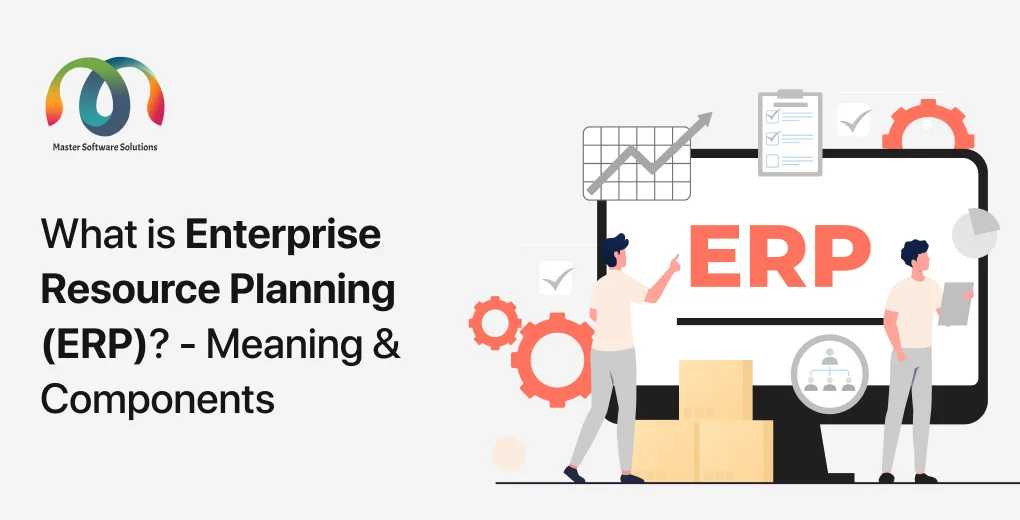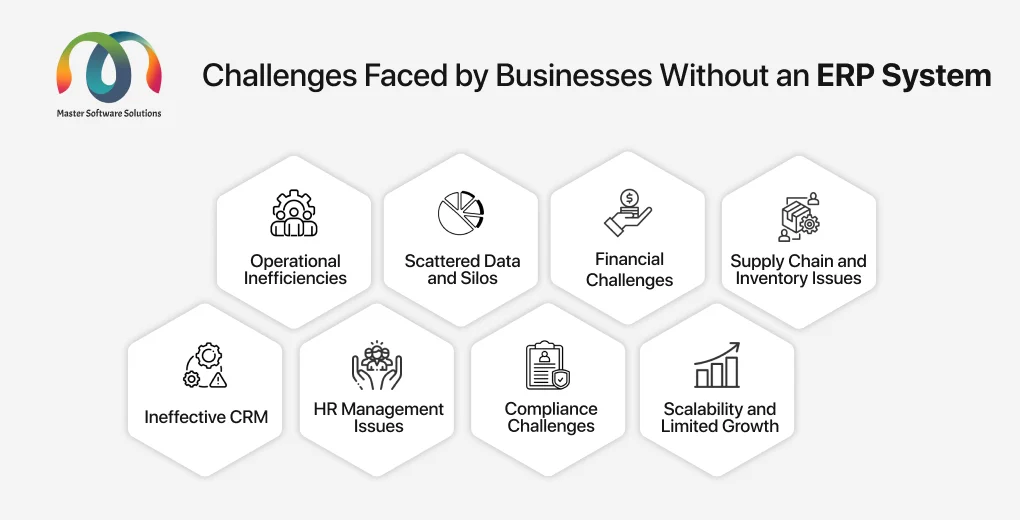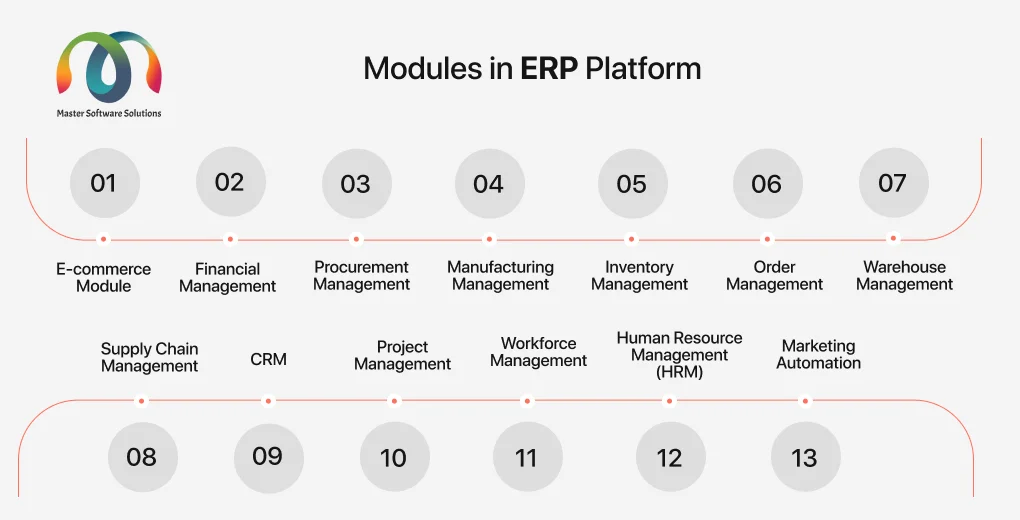What is Enterprise Resource Planning (ERP)? – Meaning & Components
Managing your business on a spreadsheet becomes irrelevant and tedious as it grows. This is where enterprise resource planning or ERP, comes into your business’s landscape. The ERP is a one-stop solution that integrates all the process modules your business needs to run.
This blog article covers all the aspects you need to know about an ERP system, which include:
This blog covers;
What is Enterprise Resource Planning?
Enterprise resource planning is an integrated system companies use to manage and integrate essential aspects of their businesses. The system integrates various departments of your business, including accounting, supply chain management, inventory management, manufacturing, sales & marketing, and HR, to enable them to plan their resources. There are various ERP systems, like Microsoft Dynamics 365 and Odoo that centralize the data that collects inputs from these departments and provides insights and internal control.
Key takeaways
- The ERP system integrates various business aspects and provides a single database, that can be accessed easily anywhere and anytime.
- The ERP system provides an integrated approach to your business operations, like accounting, supply chain management, inventory management, analytics, marketing, and sales.
- The system provides end-to-end visibility and traceability, that enable you to identify and rectify inefficiencies, opening growth opportunities.
- The ERP system can only be effective if you implement it properly. The company must ensure the ERP is implemented, customized, and integrated properly.
Challenges faced by businesses without an ERP system
It might be easy to manage if you are small, but as your business grows, managing your business becomes tedious and full of errors. Here are the ways your company might suffer without ERP implementation:
Operational inefficiencies
Mostly businesses manage their operations manually, which leads to operational efficiencies, reducing productivity and profitability. The operational challenges faced without an ERP system are:
- Time-consuming processes and a lack of real-time tracking result in data discrepancies and lost information.
- A higher risk of human errors leads to inaccurate data, financial disparity, and reduced customer trust in your brand. It slows the order-to-cash cycle, disturbs the supply chain, and extends financial reporting time.
- Lack of automation results in manual repetitive tasks, which reduce productivity, and inefficient resource allocation, leading to burnout.
Scattered data and silos
You might be using multiple systems to manage your business operations, including legacy and operation-specific systems, like inventory management software, payment management systems, or order management systems. The challenges faced in managing a business with multiple systems:
- Different systems store data in various formats. It is challenging to collect and integrate accurately.
- Integrating data from multiple systems needs third-party software, which can lead to delays and inconsistencies.
- Data silos hinder business efficiency and collaboration and limit employee access to the shared data.
- Lack of real-time information delays decision-making, leading to outdated information, an agile approach, and irrelevant strategic planning.
Financial challenges
Manual management of finances is tedious, which can lead to data inaccuracies. Currently, you might rely on manual management of finances or fragmented systems. These systems can lead to:
- Inaccurate and delayed financial reporting.
- Data inconsistencies and errors from fragmented systems.
- Inefficient manual data collection and interdepartmental communication issues.
- Limited real-time financial performance visibility.
Supply chain issues and inventory problems
You might face significant supply chain disruptions and inefficient inventory management issues if you manually track or use fragmented systems to manage your business. Supply chain issues and inventory management challenges you might face are:
- Data errors and inconsistencies result in overstocking or stockouts.
- Not having optimum inventory leads to missed sales opportunities or product spoilage.
- Limited real-time inventory and supply chain tracking.
- Reduced customer satisfaction and experience.
Ineffective customer relationship management
Manually managing your customers and providing them with personalized experiences can be challenging. Customer relationship management consists of effective marketing, sales, and customer service. Inefficiency in managing them can lead to:
- Manual data errors hinder the personalized experience.
- Inaccuracies, communication errors, and missed engagement opportunities.
- Increased customer dissatisfaction and churn rate.
Human resource management issues
Businesses need help with employee management due to manual onboarding and performance reviews, affecting employee satisfaction and business productivity. The human resource management challenges are:
- Scattered data increases data security risks.
- Reporting and audit trail management challenges.
- HR compliance risks and reporting.
- Reduced employee engagement and retention.
Compliance challenges and risk management
To operate in a certain industry, you should comply with regulations set by different regulatory bodies. It is easier to track industrial compliance with an appropriate system. Compliance challenges you might face are:
- Understanding the complex regulatory framework.
- Depending on manual tasks can lead to errors.
- Limited resources to track regulatory compliance activities.
- Non-compliance risk penalties include legal liabilities, operational disruptions, and reputation damage. This can impact your business stability and brand image.
Scalability and limited growth
Your fragmented systems might become irrelevant once your businesses grow. These systems cannot adapt to your business expansion and increased data. You might face these challenges:
- Inflexible fragmented systems start to lag as the information in the system increases.
- They have limited internal storage and do not scale with your business.
- You might face customization and integration challenges due to its inflexible nature.
ERP – modules and features
The ERP system is an integrated system comprising various modules with advanced features, offering a unified approach to your business. The system can be customized and integrated with third-party tools to provide custom solutions for your special business requirements. The core modules include:
E-commerce module
The e-commerce module includes end-to-end tools to manage your e-commerce operations, from ordering to deliveries. The features of the e-commerce module are:
- Online order management
- Product catalog management
- Shopping cart integration
- POS system integration
- Payment gateway integration
- Order tracking and fulfillment
- Inventory synchronization
- Customer registration and login
- Order status updates
Financial management
The ERP solutions allow you to manage and track the flow of finance, offering complete visibility into the operations. The key features of the financial management module are:
- General ledger
- Accounts payable
- Accounts receivable
- Budgeting and forecasting
- Financial reporting and analytics
- Cash management
Procurement management
The procurement management module enables you to manage purchasing raw materials or finished goods. The features of the procurement module include:=
- Supplier management and tracking
- Purchase order management
- Inventory management integration
- Contract management
- Procurement analytics and reporting
- Automated workflows
Manufacturing management
The ERP system allows you to coordinate with an end-to-end product manufacturing process. It enables you to monitor the progress, ensuring the production demands are met. The features of manufacturing management in ERP are:
- Bill of Materials (BOM) management
- Production scheduling
- Work order management
- Material requirements planning (MRP)
- Capacity planning
- Quality control and inspection
- Product costing and routing
- Shop floor control
Inventory management
The inventory management in ERP provides SKU levels and updates the number in real-time. This module aims to optimize inventory levels to prevent stockouts and overstocking. The features offered by the ERP system for inventory management are:
- Stock level tracking
- Stock location and bin management
- Inventory reporting and analytics
- Automatic stock replenishment
- Serial number and batch tracking
- Inventory transfer and adjustment
- Barcode scanning integration
Order management
ERP offers an omnichannel order management approach. It unifies orders from different sources into a single system, speeding up the order fulfillment process. The order management features of ERP are:
- Order collection and processing
- Order status tracking
- Order fulfillment and shipping
- Returns and refunds management
- Order reporting and analytics
- Automated order routing
- Credit check and approval
- Tax calculation
Warehouse management
The warehouse management module manages and tracks the product receiving, picking, packing, and shipping, improving efficiency and saving time. The features of warehouse management in ERP are:
- Warehouse organization
- Inventory putaway and picking
- Shipping and receiving management
- Stock counting and reconciliation
- Warehouse reporting and analytics
- Automated storage and retrieval
- Integration with RFID and barcode scanning
Supply chain management
The supply chain management modules enable you to monitor the flow of goods from suppliers through manufacturing and into the hands of end consumers. The ERP system streamlines the process, improving operational efficiency and reducing supply chain disruptions. The features of the supply chain modules are:
- Procurement and purchasing
- Supplier management
- Demand forecasting
- Inventory optimization
- Logistics and transportation management
- Supply chain analytics and reporting
- Collaboration and communication tools
Customer relationship management
ERP systems have integrated CRM software that allows you to manage your customer’s journey from marketing through sales and customer service. Automation and AI implementation in marketing, sales, and customer services can streamline the process, allowing you to offer a personalized experience and minimizing customer issue resolution time. The features of the CRM module are:
- Contact and account management
- Sales force automation
- Marketing automation
- Customer service and support
- Lead and opportunity management
- Sales analytics and forecasting
- Customer segmentation and profiling
- Integration with social media
Project management
The ERP system offers a project management module for service-based businesses to plan and manage projects, including finances. The module simplifies client management and billing processes. The features of a project management module are:
- Project planning and scheduling
- Task and resource allocation
- Time tracking and billing
- Project budgeting and costing
- Risk management and mitigation
- Project reporting and analytics
- Collaboration and communication tools
- Integration with charts, like Gantt and calendars
Workforce management
Workforce management in ERP tracks and manages employee attendance and working hours. The system allows you to record absenteeism and team, department, and individual employee productivity. The features of the workforce management module in ERP are:
- Employee scheduling and rostering
- Time and attendance tracking
- Leave and absence management
- Labor cost tracking and analysis
- Performance management and appraisal
- Training and development management
- Workforce analytics and reporting
- Integration with payroll systems
Human resource management (HRM)
The HRM, or human capital management (HCM) module, is similar to the workforce management module. It records employee information, including available PTO and performance reviews. The features of the HRM module in ERP are:
- Employee data management
- Recruitment and applicant tracking
- Benefits and compensation management
- Performance management and appraisal
- Training and development management
- Succession planning and career development
- Compliance and regulatory management
- HR analytics and reporting
Marketing automation
The ERP solution automates marketing and enables you to manage all your marketing efforts, including email, social marketing, and web. The system allows you to optimize and personalize your marketing approach. The features of marketing automation include:
- Campaign management
- Lead generation and management
- Email marketing and automation
- Social media integration and management
- Content management and publishing
- Marketing analytics and ROI tracking
- Customer segmentation and profiling
- Marketing automation workflow
Benefits of ERP system implementation
Implementing ERP has become a strategic investment to grow and scale your business in this competitive digital era. The enterprise resource planning software solution offers various benefits that can help you improve efficiency and productivity, and bring agility to your business. The benefits of implementing ERP solutions into your business are:
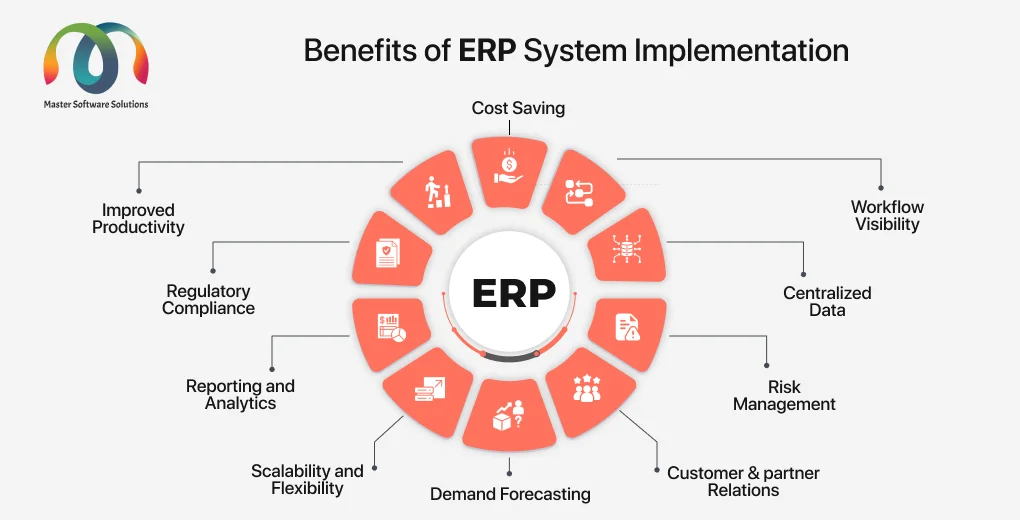
Cost saving
- Automating repetitive tasks minimizes errors and the need for employees, reducing administrative costs.
- End-to-end visibility and traceability make spotting cost-increasing inefficiencies easy. You can use efficient resources to improve the operations.
Improved productivity
- ERP enables a seamless flow of information within various departments of the business.
- It allows real-time access to the project updates, saving time and improving operational productivity.
Workflow visibility
- Your employees can monitor and track performance and see project status relevant to their jobs.
- Visibility allows your managers to fetch updates quickly without having to go to each employee separately, saving time.
Regulatory compliance
- ERP offers audit trails by tracking transaction lifecycles and adhering to required approval workflows.
- Automation reduces the chances of errors, which prevents compliance confusion.
- SaaS ERP platforms have required tools to help businesses comply with PCI-DSS compliance.
Centralized data
- Organized data in one place prevents data silos.
- Provides valuable business insights to evaluate business KPIs.
- Access relevant data to make rational decisions.
Reporting and analytics
- Track essential KPIs and set up metrics and comparisons.
- Track the financial business health and create strategies to improve processes to increase profits.
Risk management
- ERP offers granular access control (GAC) to strengthen financial controls and prevent fraud.
- Prevent errors in data that can lead to lost data or data silos.
Scalability and flexibility
- The ERP platform is highly scalable and can accommodate the increasing data as your business grows.
- The ERP solution offers the flexibility to customize it according to the business requirements.
Strengthens customer and partner relationship
- The system provides insights into suppliers, shipping centers, and service providers.
- You can track customer responses and manage ticketing and returns.
Demand forecasting
- You can adjust your business plan based on the real-time data.
- It allows synchronization between ERP and planning and budgeting.
ERP – Use Cases
The ERP system provides real-time, which is essential for most businesses. Here are some industries that can benefit from ERP implementation:
E-commerce
ERP solutions can help you streamline operations like order management, inventory control, customer relationship management, and financial reporting. You can integrate your online store applications, automate workflows, and get real-time insights into stock levels, sales performance, and customer behavior.
Education
The enterprise resource planning platforms simplify student and staff information, course registration, financial aid processing, HR operation, and campus facilities management. You can manage student lifecycle data, financial resources, and operational workflows.
Fast-moving Consumer Goods
The ERP software solution helps FMCG companies manage large inventories, track supply chain logistics, and monitor sales performance. It automates demand forecasting, optimizes production planning, and ensures regulatory compliance.
Healthcare
ERP systems help healthcare providers manage patient records, billing, supply chains, and regulatory compliance. They integrate administrative functions with medical data, reduce manual paperwork, and provide real-time access to critical information across departments.
Logistics
The enterprise resource planning software integrates a supply chain management module to enhance fleet management, shipping, and tracking, offering real-time insights into delivery schedules and transportation costs. This helps reduce delays and optimize resource allocation.
Manufacturing
ERP systems streamline production planning, inventory management, procurement, and quality control. You can automate your shop floor operations and get real-time insights into production metrics to improve efficiency, reduce waste, and manage complex supply chains.
Professional Service
ERP integrates project management, time-tracking, billing, and resource allocation, ensuring efficient project execution, accurate financial reporting, and better client relationship management.
Retail
You can manage inventory, pricing, customer loyalty programs, and multi-channel sales strategies. It ensures seamless integration between physical stores and online platforms for real-time inventory tracking and personalized shopping experience for improved customer satisfaction.
Warehousing
ERP solutions automate inventory control, order fulfillment, and warehouse space usage. It improves picking accuracy, reduces order fulfillment time, and provides real-time stock tracking.
Software & IT service
Implementing an ERP system can manage project timelines, resource allocation, client invoicing, and financial reporting. You can track project progress, manage support tickets, and enhance team collaboration, improving service delivery and profitability.
ERP implementation challenges
Building ERP can be the best strategic move for your business; however, implementing it can be challenging. You should know the potential blockers you may face before ERP implementation. Some of the major challenges faced while implementing ERP are:
Budget considerations – ERP solutions are expensive and mostly adopted by big businesses. However, SaaS-based solutions with recurring payment models are more accessible and are designed for mid-sized and small businesses.
Employee training – Using ERP is challenging as it requires adequate training to make the most of the system. Your employees should be well-versed in the system to operate the system efficiently.
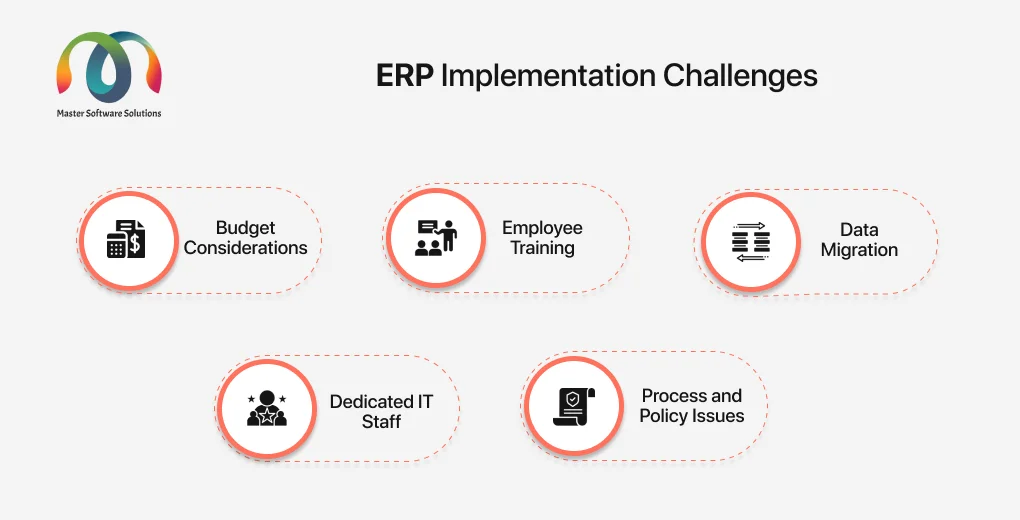
Data migration – It is crucial to ensure data is migrated in the relevant format from one system to another for data compatibility. You must review your data, transform it into the right format, cleanse it, and then migrate it while ensuring data accuracy.
Dedicated IT staff – You’ll need to hire a dedicated team to manage your ERP solution, which can be expensive. You can also choose to hire ERP consulting service providers to handle your ERP implementation, integration, migration, and customization tasks.
Process and policy issues – ERP can improve operational accuracy; however, it cannot help you improve process and policy issues. On the contrary, ERP can help you identify these inefficiencies and work on them. You can hire ERP consultants, who can help you analyze business processes, identify blockers, and provide solutions for them.
How does Master Software Solutions help with ERP implementation?
Master Software Solutions is an IT consulting and development service provider that works on enterprise resource planning systems, like Microsoft Dynamics 365 and Odoo, to provide end-to-end solutions for retail and logistics in the supply chain. We are a team of 90+ proficient technical professionals with over 12 years of experience in supply chain management. Discuss your business with our ERP experts to get a free audit.
